An Investigation into the Effect of Scour on the Loading and Deformation Responses of Monopile Foundations
Abstract
:1. Introduction
2. The Influence of Pile Diameter on the Initial Stiffness of the p-y Curve
3. The Influence of Scour on Ultimate Soil Resistance
4. The Influence of the Modification of the Initial Modulus of Subgrade Reaction and the Ultimate Soil Resistance on the p-y Curve
5. Foundation Stiffness of Monopile
6. A Case Study for the Loading and Deformation Response of Monopile Foundation with Scour at the Chang-Bin Wind Farm
6.1. Reference Offshore Wind Turbine of National Renewable Energy (NREL)
6.2. Loading and Deformation Response of Monopile Foundation
6.3 Discussion
7. Conclusions
Acknowledgments
Author Contributions
Conflicts of Interest
References
- European Wind Energy Association. The European Offshore Wind industry—Key Trends and Statistics 2016; European Wind Energy Association: Brussels, Belgium, 2017. [Google Scholar]
- Lombardi, D.; Bhattacharya, S.; Wood, D.M. Dynamic soil–structure interaction of monopile supported wind turbines in cohesive soil. Soil Dyn. Earthq. Eng. 2013, 49, 165–180. [Google Scholar] [CrossRef]
- Arany, L.; Bhattacharya, S.; Macdonald, J.; Hogan, S.J. Design of monopiles for offshore wind turbines in 10 steps. Soil Dyn. Earthq. Eng. 2017, 92, 126–152. [Google Scholar] [CrossRef]
- Poulos, H.G.; Davis, E.H. Pile Foundation Analysis and Design; Wiley: Chichester, UK, 1980. [Google Scholar]
- Kuo, Y.S. On the Behavior of Large-Diameter Piles Under Cyclic Lateral Load. Ph.D. Thesis, Leibniz University, Hannover, Germany, 2008. [Google Scholar]
- API RP 2GEO. Geotechnical and Foundation Design Considerations; American Petroleum Institute: Washington, DC, USA, 2011. [Google Scholar]
- Standard DNVGL-ST-0126. Support Structures for Wind Turbines; DNVGL AS: Oslo, Norway, 2016. [Google Scholar]
- Abdel-Rahman, K.; Achmus, M. Finite element modelling of horizontally loaded monopile foundations for offshore wind energy converters in Germany. In Proceedings of the First International Symposium on Frontiers in Offshore Geotechnics, Perth, Australia, 19–21 September 2005; Taylor and Francis: Boca Raton, FL, USA; pp. 391–396. [Google Scholar]
- Lesny, K.; Wiemann, J. Finite-element-modelling of large diameter monopiles for offshore wind energy converters. In Proceedings of the GeoCongress 2006, Atlanta, GA, USA, 26 February–1 March 2006; American Society of Civil Enginering: Reston, VA, USA; pp. 1–6. [Google Scholar]
- Sørensen, S.P.H.; Ibsen, L.B.; Augustesen, A.H. Effects of diameter on initial stiffness of py curves for large-diameter piles in sand. In Proceedings of the European Conference on Numerical Methods in Geotechnical Engineering, Trondheim, Norway, 2–4 June 2010; pp. 907–912. [Google Scholar]
- Sørensen, S.P.H. Soil-Structure Interaction for Non-Slender, Large-Diameter Offshore Monopiles. Ph.D. Thesis, Aalborg University, Aalborg, Denmark, December 2012. [Google Scholar]
- Kallehave, D.; Thilsted, C.L.; Liingaard, M.A. Modification of the API py Formulation of Initial Stiffness of Sand, Offshore Site Investigation and Geotechnics: Integrated Technologies-Present and Future; Society of Underwater Technology: London, UK, 2012. [Google Scholar]
- Sumer, B.M.; Fredsøe, J. The Mechanics of Scour in the Marine Environment; World Scientific: Singapore, 2002. [Google Scholar]
- Whitehouse, R.; Sutherland, J.; O’Brien, D. Seabed scour assessment for offshore windfarm. In Proceedings of the 3rd International Conference on Scour and Erosion, Gouda, The Netherlands, 3–5 July 2006. [Google Scholar]
- Li, Y.; Chen, X.; Fan, S.; Briaud, J.L.; Chen, H.C. Is scour important for pile foundation design in deepwater? In Proceedings of the Offshore Technology Conference, Houston, TX, USA, 4–7 May 2009. [Google Scholar]
- Qi, W.G.; Gao, F.P. Physical modeling of local scour development around a large-diameter monopile in combined waves and current. Coast. Eng. 2014, 83, 72–81. [Google Scholar] [CrossRef]
- Design of Offshore Wind Turbine Structures; DNV-OS-J101; Det Norske Veritas AS: Oslo, Norway, 2004.
- Achmus, M.; Kuo, Y.S.; Abdel-Rahman, K. Numerical investigation of scour effect on lateral resistance of windfarm monopiles. In Proceedings of the Twentieth International Offshore and Polar Engineering Conference, Beijing, China, 20–25 June 2010. [Google Scholar]
- Kishore, Y.N.; Rao, S.N.; Mani, J.S. The behavior of laterally loaded piles subjected to scour in marine environment. KSCE J. Civ. Eng. 2009, 13, 403–408. [Google Scholar] [CrossRef]
- Sorensen, S.P.H.; Ibsen, L.B. Assessment of foundation design for offshore monopiles unprotected against scour. Ocean Eng. 2013, 63, 17–25. [Google Scholar] [CrossRef]
- Prendergast, L.J.; Hester, D.; Gavin, K.; O’Sullivan, J.J. An investigation of the changes in the natural frequency of a pile affected by scour. J. Sound Vib. 2013, 332, 6685–6702. [Google Scholar] [CrossRef]
- Prendergast, L.J.; Gavin, K.; Doherty, P. An investigation into the effect of scour on the natural frequency of an offshore wind turbine. Ocean Eng. 2015, 101, 1–11. [Google Scholar] [CrossRef]
- Zaaijer, M.B. Design Methods for Offshore Wind Turbines at Exposed Sites (OWTES)—Sensitivity Analysis for Foundations of Offshore Wind Turbines; Delft University of Technology: Delft, The Netherlands, 2002. [Google Scholar]
- Lin, C.; Bennett, C.; Han, J.; Parsons, R.L. Scour effects on the response of laterally loaded piles considering stress history of sand. Comput. Geotech. 2010, 37, 1008–1014. [Google Scholar] [CrossRef]
- Lin, C.; Han, J.; Bennett, C.; Parsons, R.L. Analysis of laterally loaded piles in sand considering scour hole dimensions. J. Geotech. Geoenviron. Eng. 2014, 140, 04014024. [Google Scholar] [CrossRef]
- Taiwan Power Company. Development of Monitoring Database and Application Module for Meteorology Mast; Taiwan Power Company: Taipei, Taiwan, 2017. [Google Scholar]
- Recommended Practice for Planning, Designing and Constructing Fixed Offshore Platforms—Working Stress Design; API RP2A-WSD; American Petroleum Institute: Washington, DC, USA, 2007.
- Titze, E. Über Den Seitlichen Bodenwiderstand Bei Pfahlgründungen. Bauingenieur-Praxis, 77; Ernst & Sohn: Berlin, Germany, 1970. [Google Scholar]
- Achmus, M.; Thieken, K.; Lemke, K. Evaluation of p-y approaches for large diameter monopiles in sand. In Proceedings of the Twenty-fourth International Ocean and Polar Engineering Conference, Busan, Korea, 15–20 June 2014. [Google Scholar]
- Brinkgreve, R.B.J.; Engin, E.; Swolfs, W.M. PLAXIS 3D 2013 Manual; Plaxis: Delft, The Netherlands, 2013. [Google Scholar]
- DNV/Risø. Guidelines for Design of Wind Turbines, 2nd ed.; Jydsk Centraltrykkeri: Viby, Denmark, 2002. [Google Scholar]
- Reese, L.C.; Cox, W.R.; Koop, F.D. Analysis of laterally loaded piles in sand. In Offshore Technology in Civil Engineering Hall of Fame Papers from the Early Years; American Society of Civil Engineers: Reston, VA, USA, 1974; pp. 95–105. [Google Scholar]
- Roulund, A.; Sumer, B.M.; Fredsøe, J.; Michelsen, J. Numerical and experimental investigation of flow and scour around a circular pile. J. Fluid Mech. 2005, 534, 351–401. [Google Scholar] [CrossRef]
- Nielsen, A.; Hansen, E. Time-varying wave and current-induced scour around offshore wind turbines. In Proceedings of the ASME 2007 26th International Conference on Offshore Mechanics and Arctic Engineering, San Diego, CA, USA, 10–15 June 2007; pp. 399–408. [Google Scholar]
- Qi, W.G.; Gao, F.P.; Randolph, M.F.; Lehane, B.M. Scour effects on p–y curves for shallowly embedded piles in sand. Geotechnique 2016, 66, 648–660. [Google Scholar] [CrossRef]
- Zaaijer, M.B. Foundation modelling to assess dynamic behaviour of offshore wind turbines. Appl. Ocean Res. 2006, 28, 45–57. [Google Scholar] [CrossRef]
- Jonkman, J.; Musial, W. Offshore Code Comparison Collaboration (OC3) for IEA Wind Task 23 Offshore Wind Technology and Deployment; National Renewable Energy Laboratory: Golden, CO, USA, 2010.
- Bush, E.; Manuel, L. The influence of foundation modeling assumptions on long-term load prediction for offshore wind turbines. In Proceedings of the ASME 28th International Conference on Ocean, Offshore and Arctic Engineering, Honolulu, HI, USA, 31 May–5 June 2009; pp. 1075–1083. [Google Scholar]
- Arany, L.; Bhattacharya, S.; Adhikari, S.; Hogan, S.J.; Macdonald, J.H.G. An analytical model to predict the natural frequency of offshore wind turbines on three-spring flexible foundations using two different beam models. Soil Dyn. Earthq. Eng. 2015, 74, 40–45. [Google Scholar] [CrossRef]
- Jung, S.; Kim, S.R.; Patil, A.; Hung, L.C. Effect of monopile foundation modeling on the structural response of a 5-MW offshore wind turbine tower. Ocean Eng. 2015, 109, 479–488. [Google Scholar] [CrossRef]
- Wang, Y.K.; Chai, J.F.; Chang, Y.W.; Huang, T.Y.; Kuo, Y.S. Development of seismic demand for chang-bin offshore wind Farm in Taiwan strait. Energies 2016, 9, 1036. [Google Scholar] [CrossRef]
- Garrad Hassan and Partners Ltd. Bladed User Manual, version 4.5; Garrad Hassan & Partners Ltd.: Bristol, UK, 2013. [Google Scholar]
- Wind Turbines—Part 3: Design Requirements for Offshore Wind Turbines; IEC 61400-3; International Electrotechnical Commission: Geneva, Switzerland, 2009.
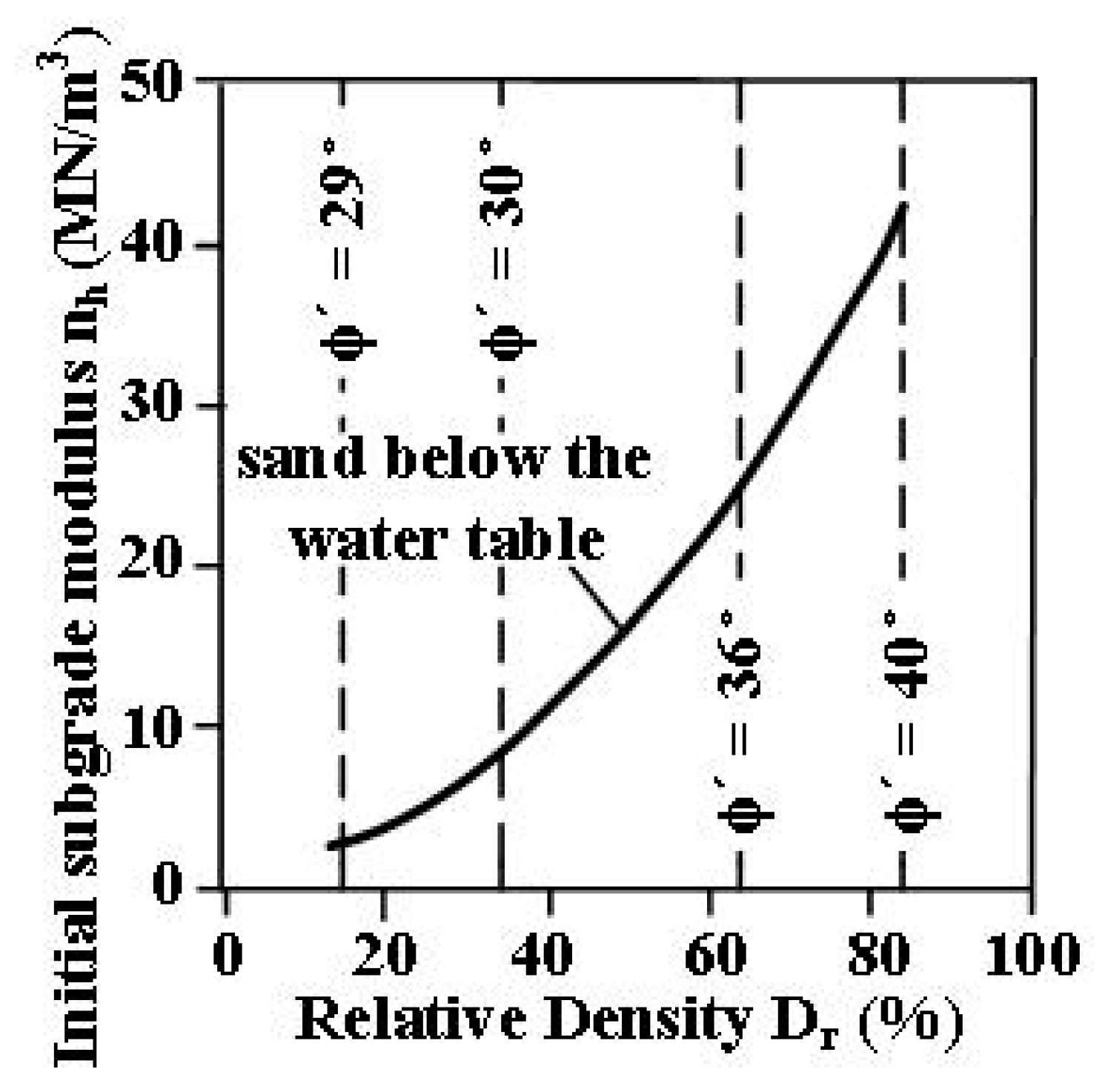
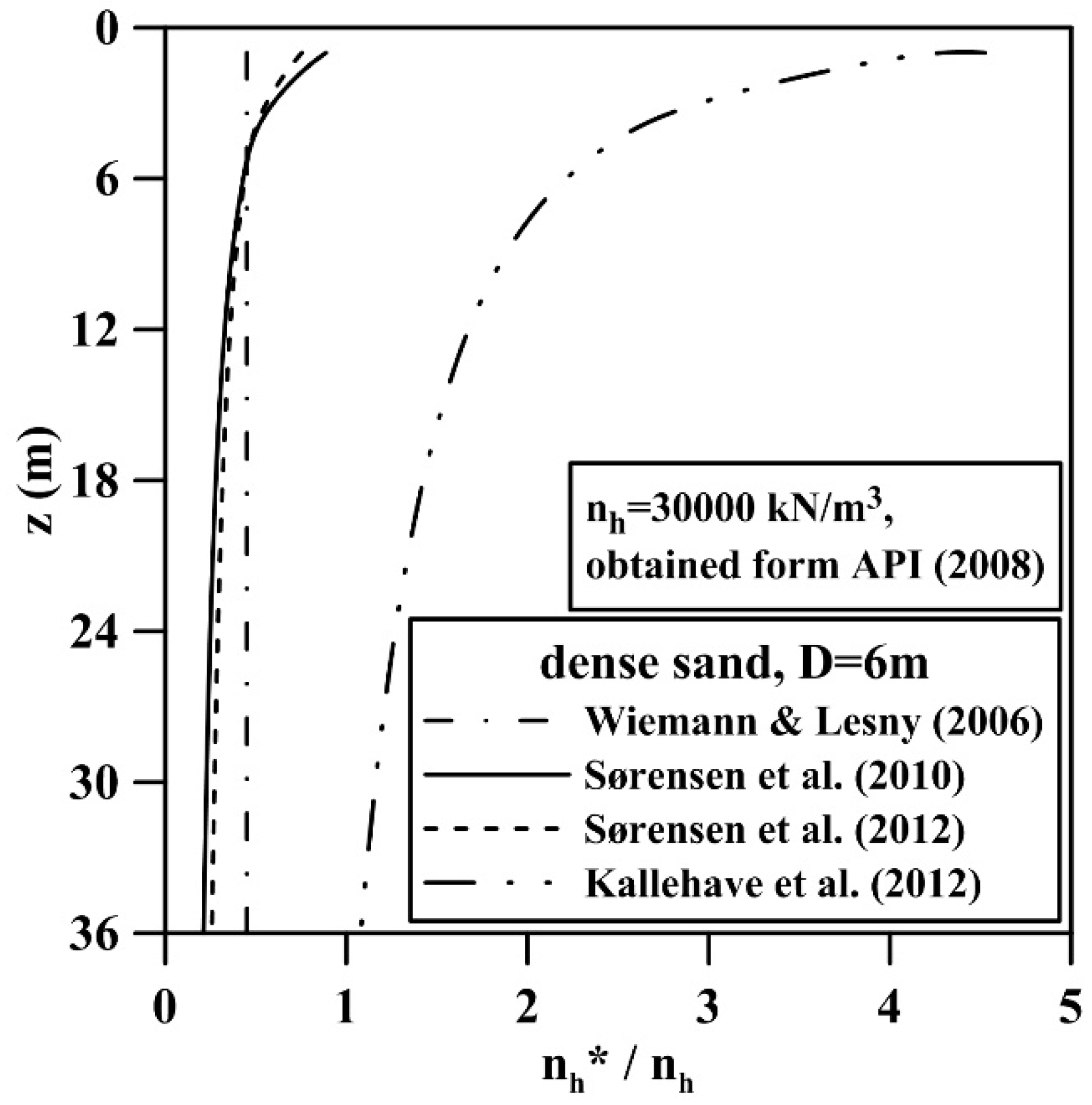
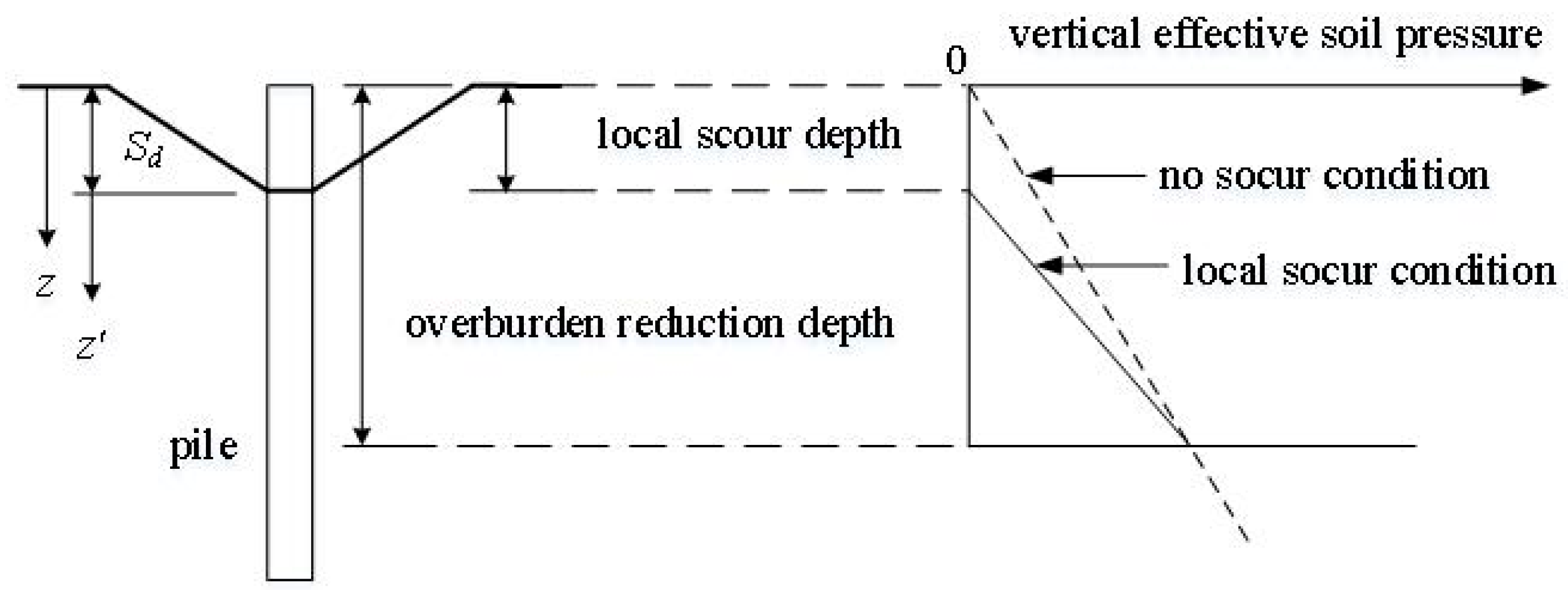
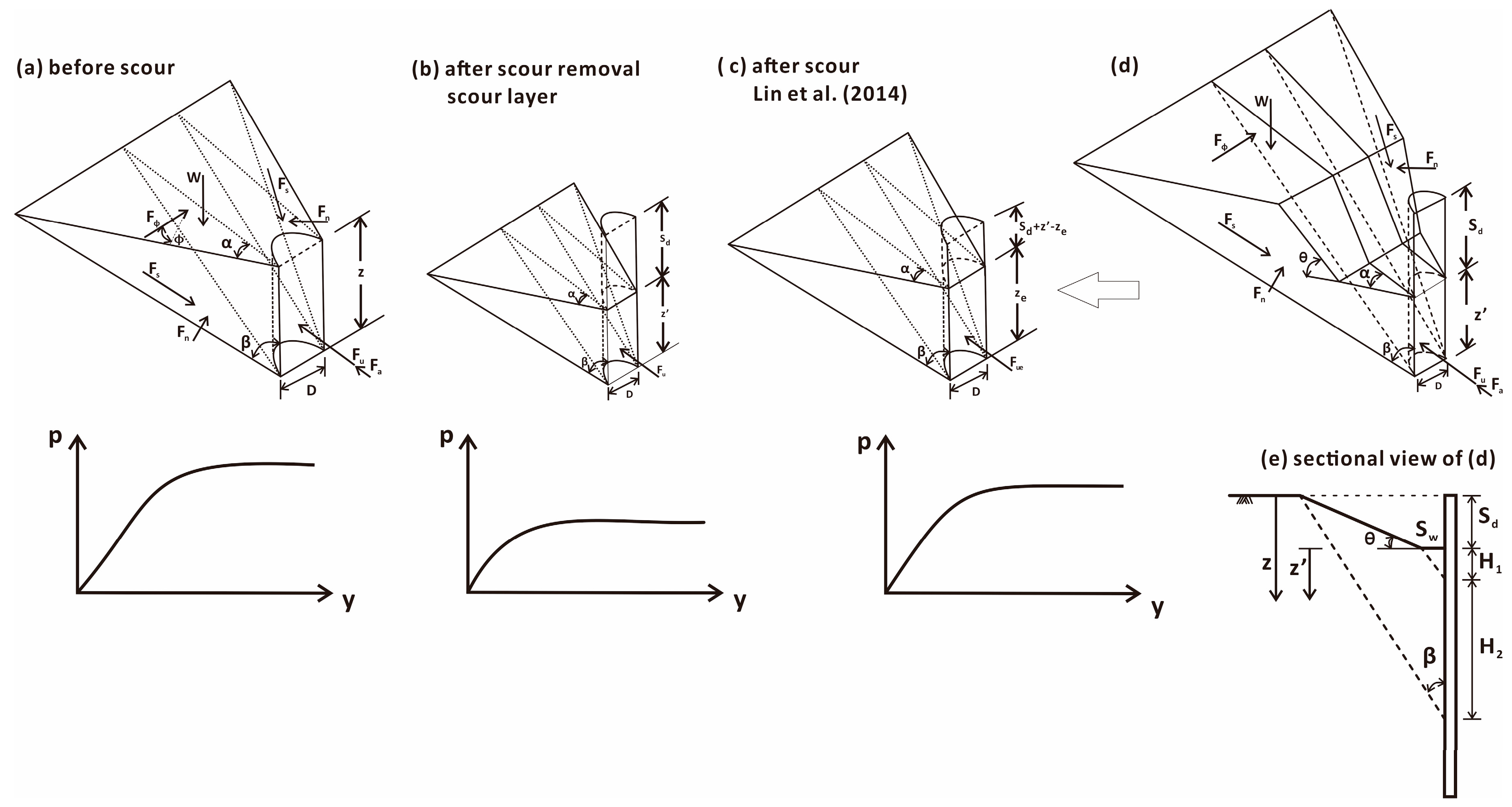

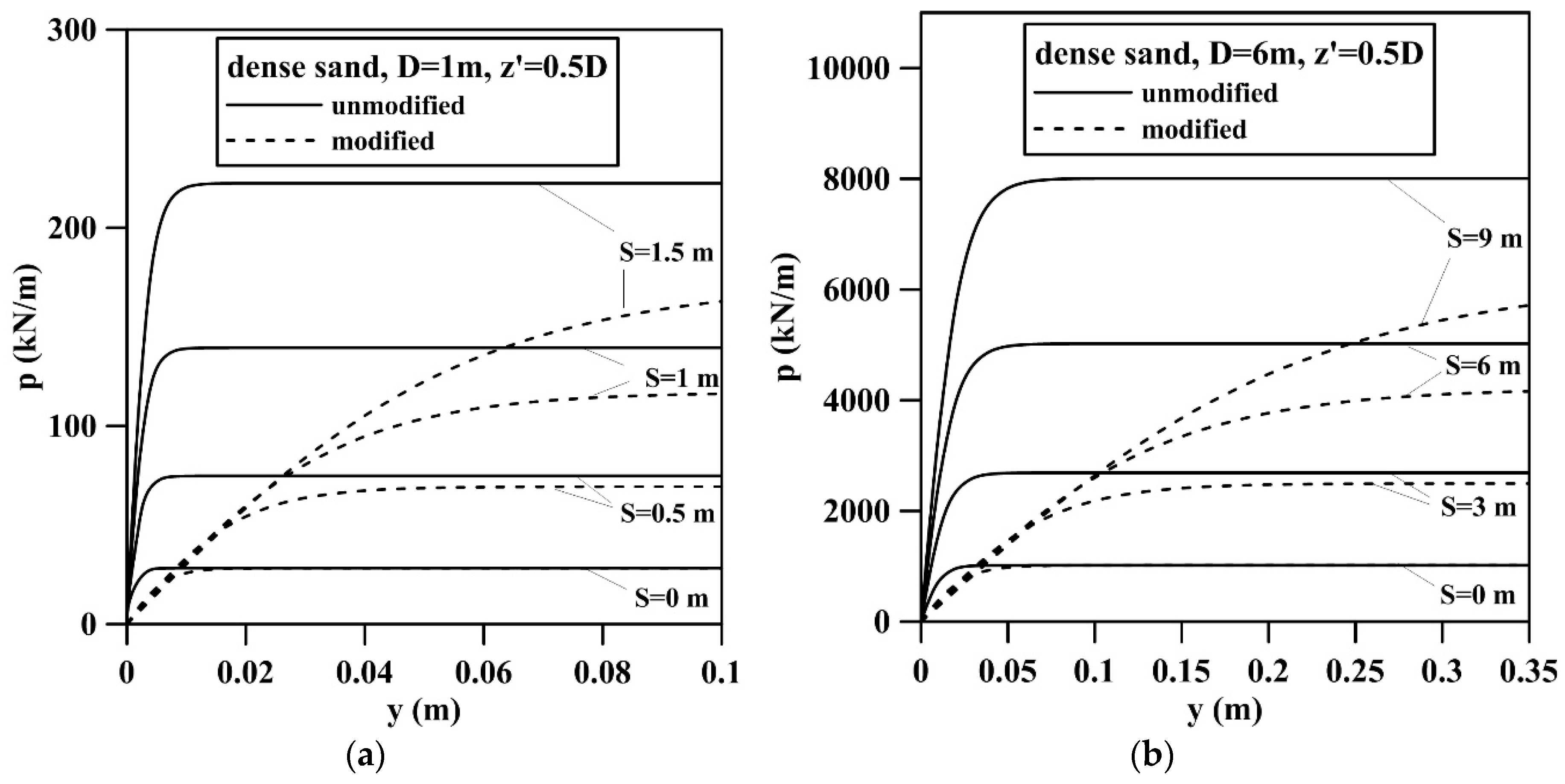
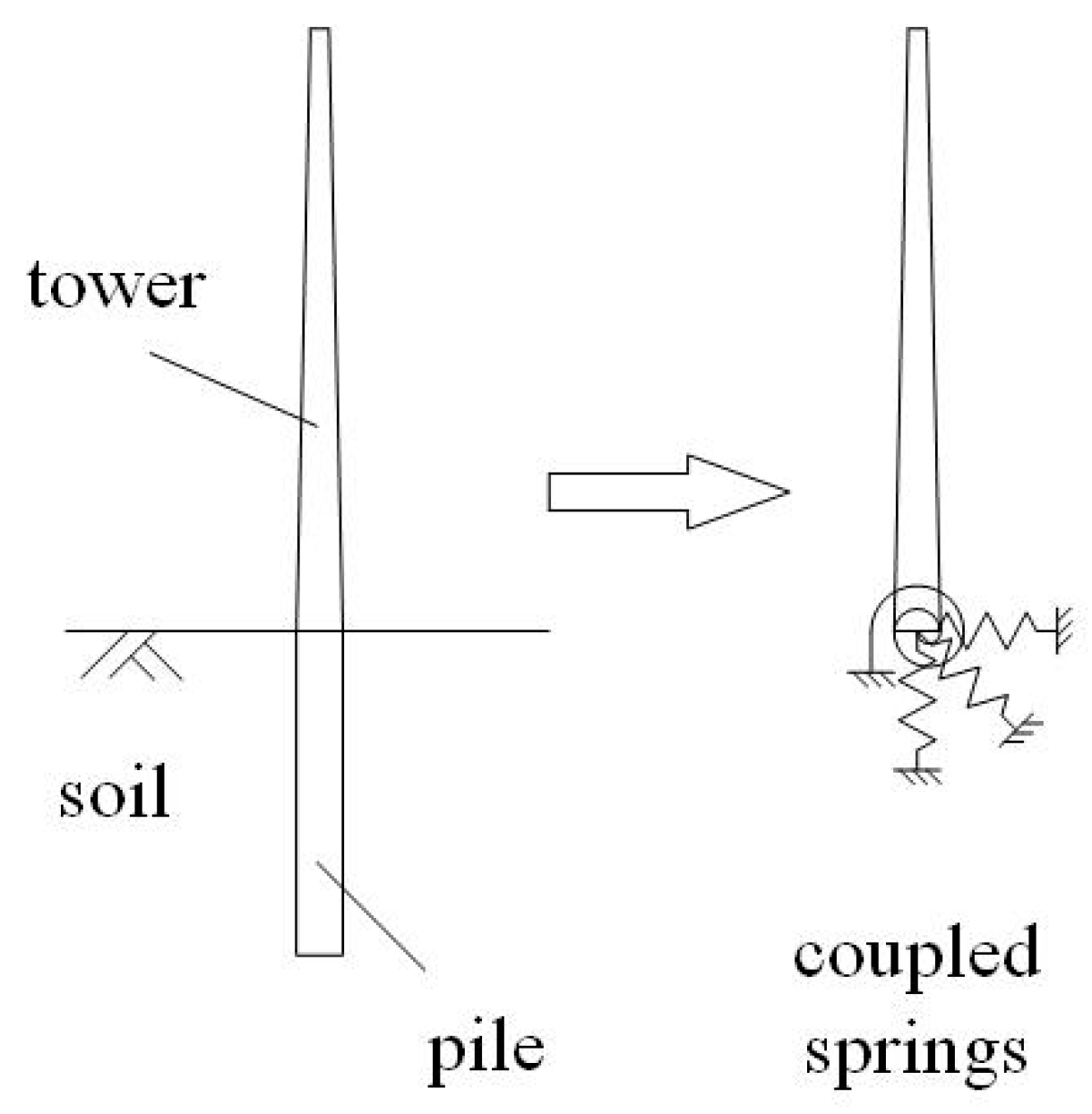
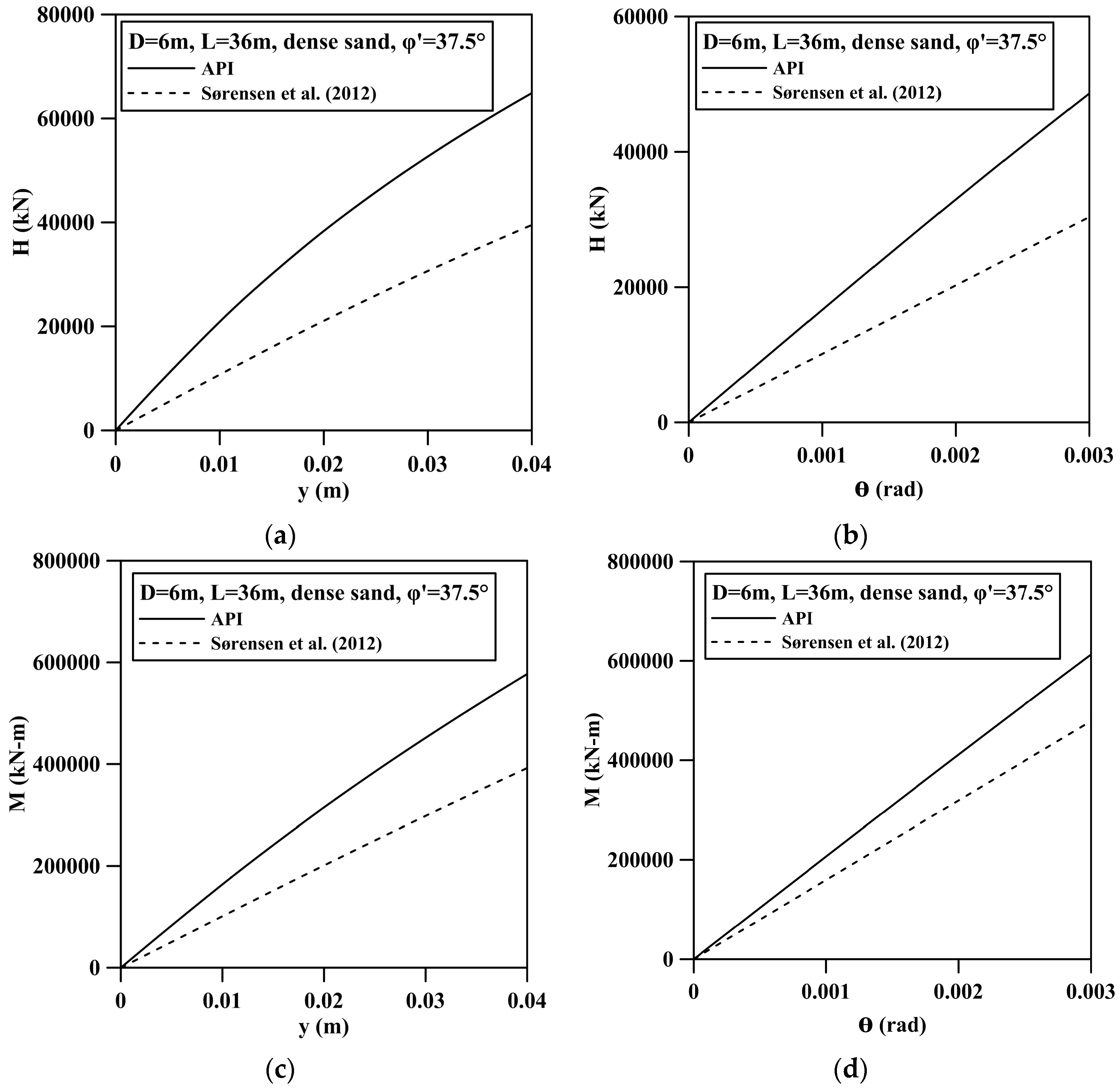
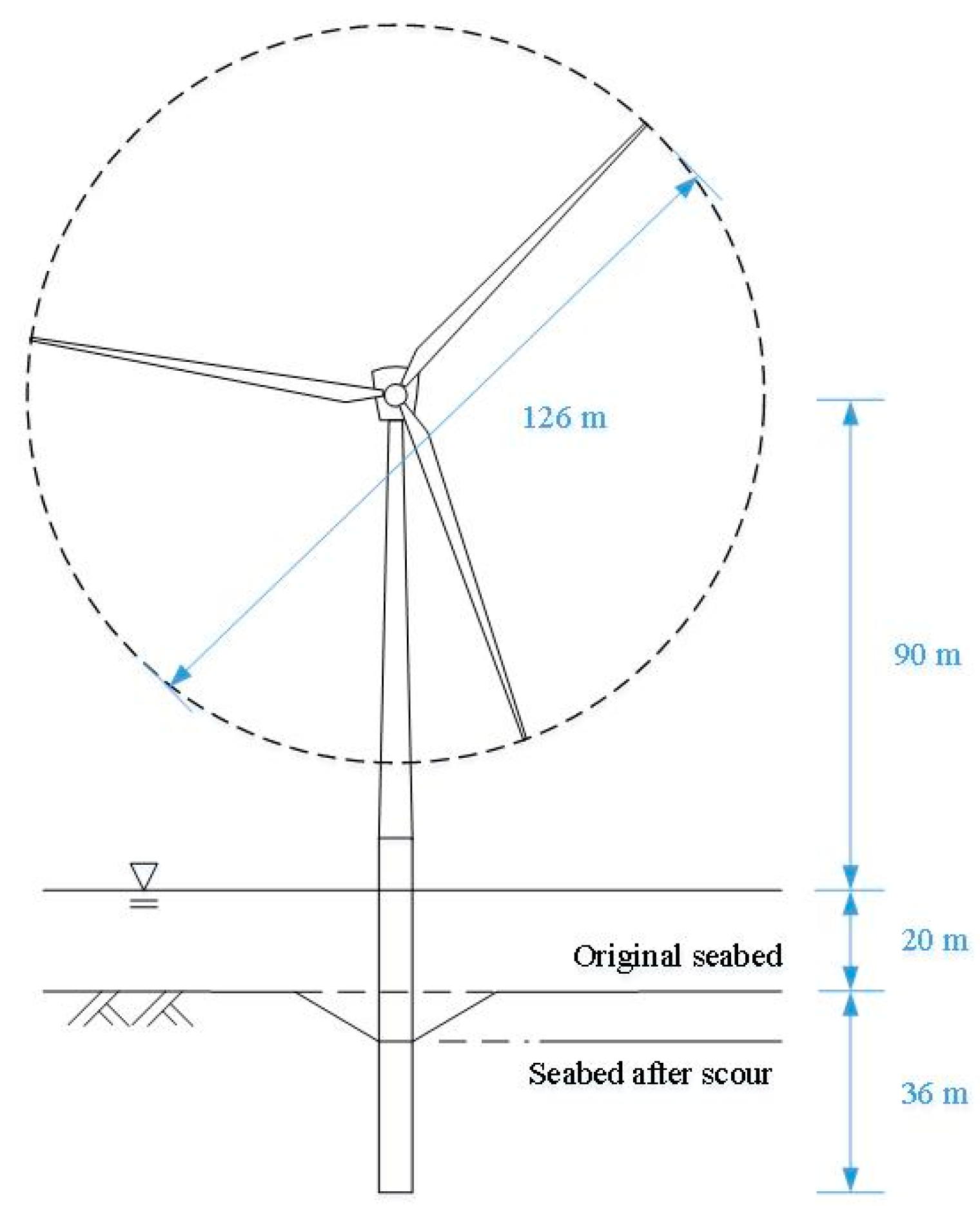
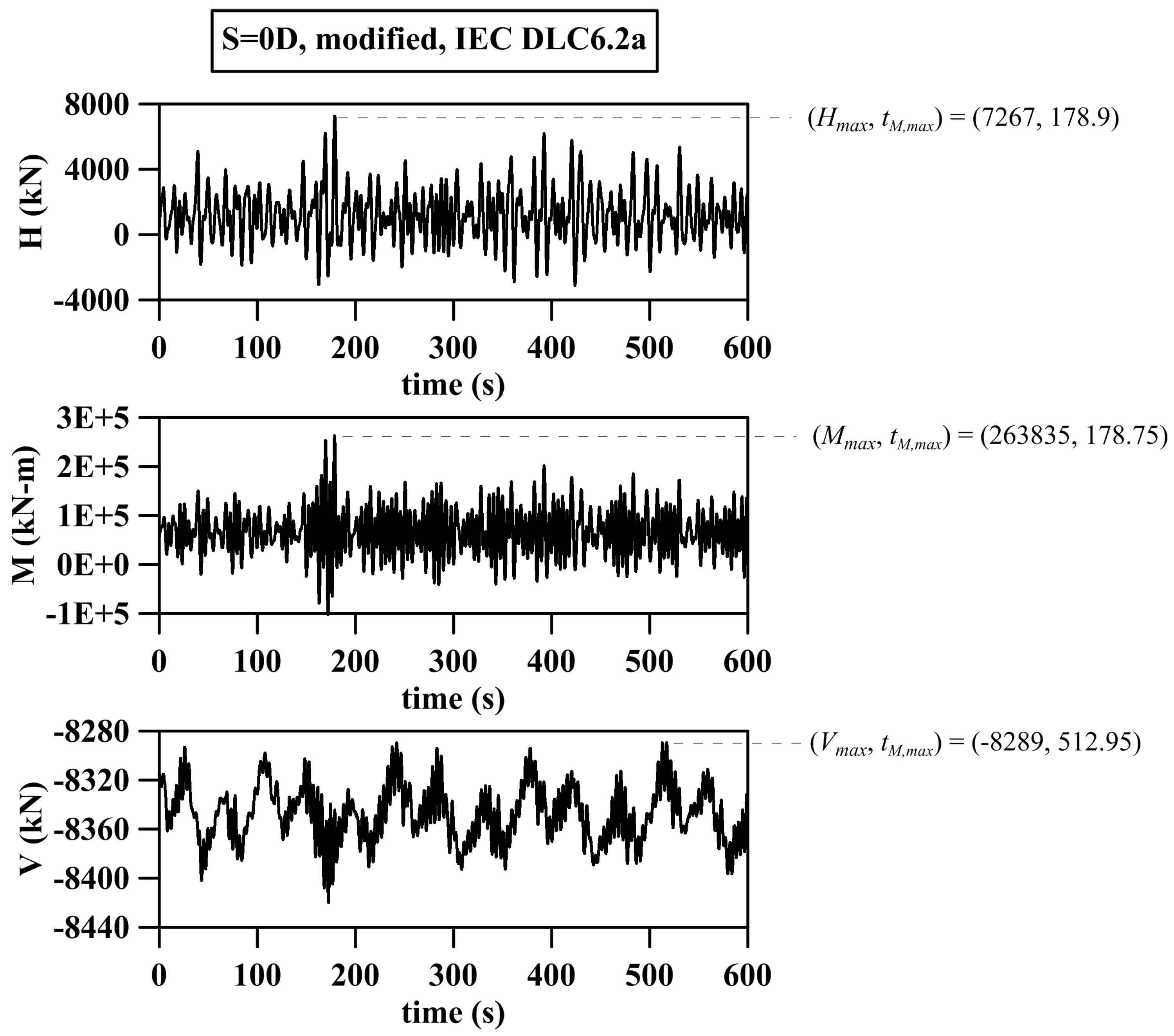
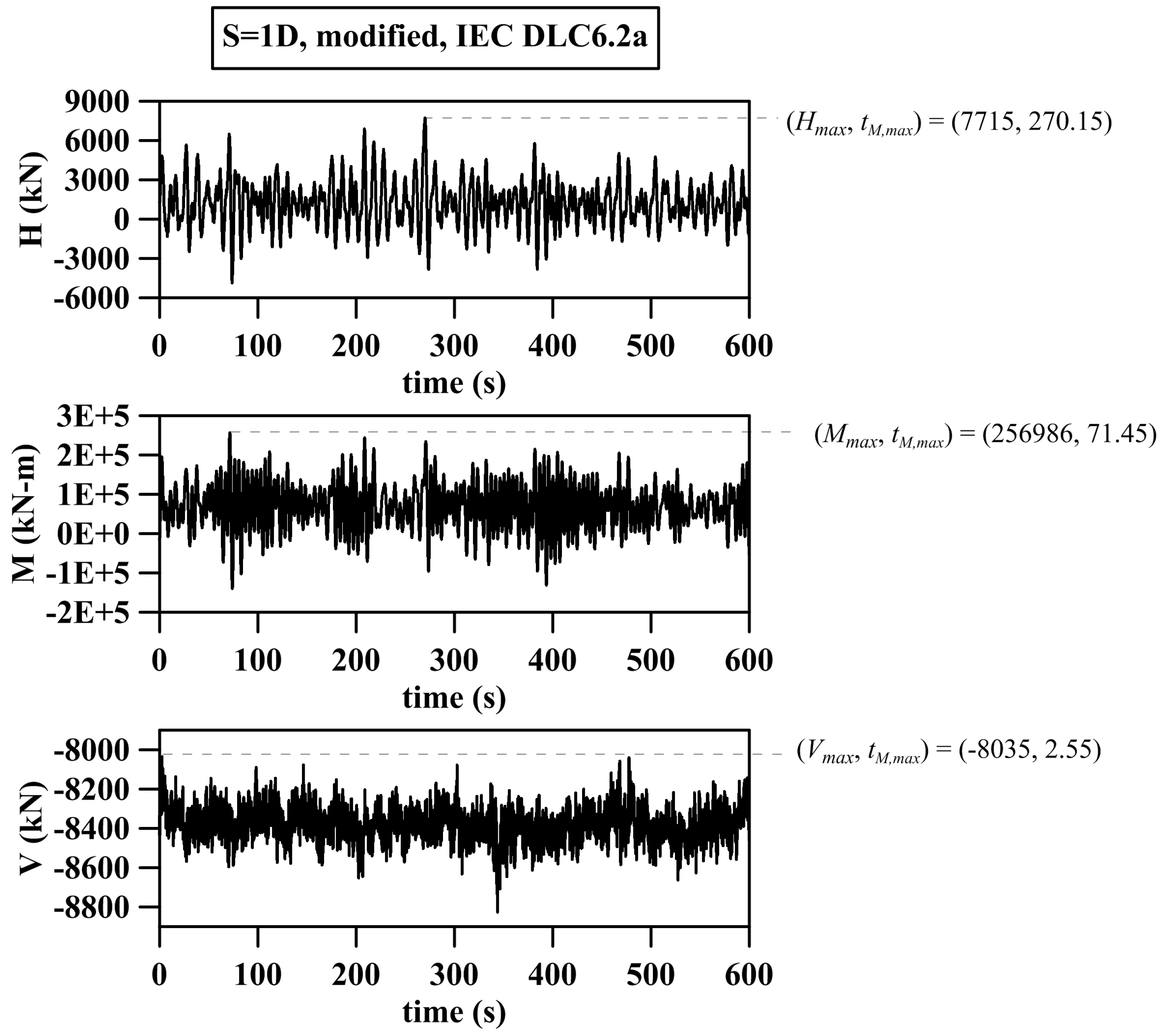
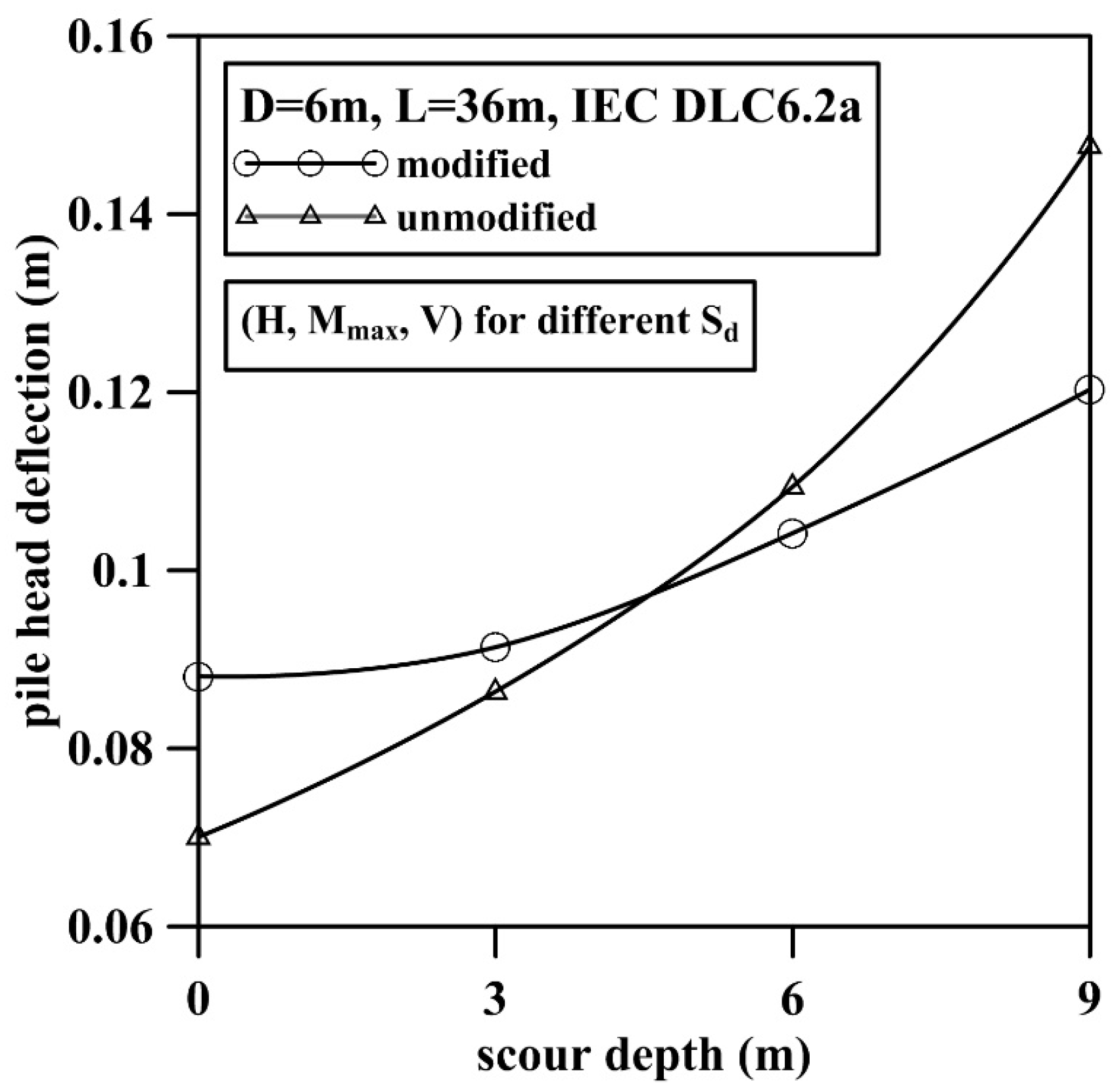
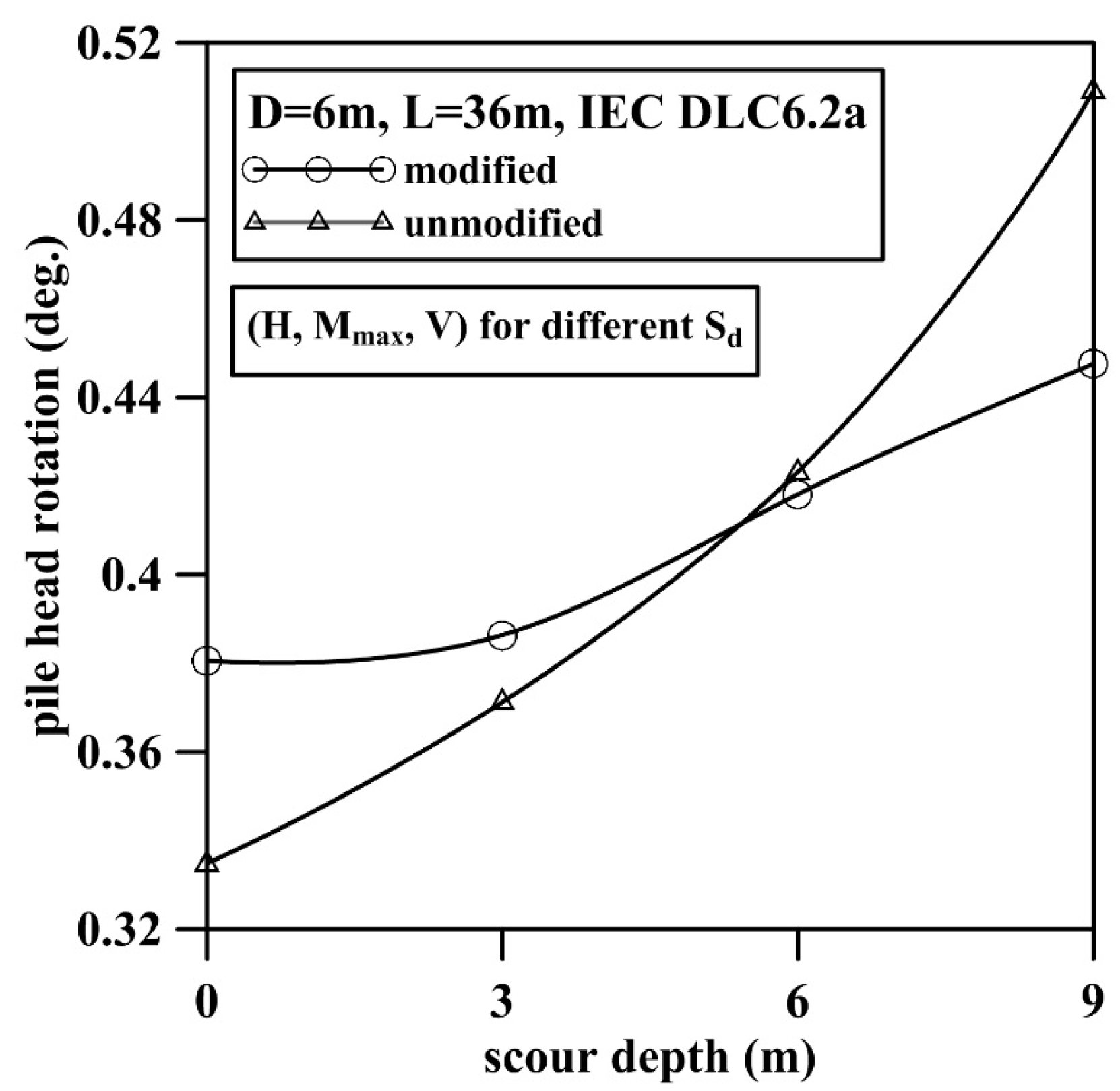
| Depth (m) | Total Lateral Force () Exerted on the Pile |
|---|---|
| Property | Value | |
|---|---|---|
| Cut-in, Rated, Cut-out wind speed | (m/s) | 3, 11.4, 25 |
| Cut-in, Rated rotor speed | (rpm) | 6.9, 12.1 |
| Rotor diameter | (m) | 126 |
| Hub height | (m) | 90 |
| Rotor, Nacelle, Tower mass | (ton) | 110, 240, 347.5 |
| Tower top diameter, Thickness | (m) | 3.87, 0.019 |
| Tower base diameter, Thickness | (m) | 6, 0.027 |
| Water depth | (m) | 20 |
| Pile diameter, Thickness, Length | (m) | 6, 0.06, 36 |
| Soil Layer | Depth (m) | Effective Unit Weight () | Friction Angle ′(°) | Initial Modulus of Subgrade Reaction () |
|---|---|---|---|---|
| Sand 1 | 0–10.8 | 8.5 | 29.5 | 5067 |
| Sand 2 | 10.8–26.1 | 9.5 | 32.0 | 13,612 |
| Sand 3 | 26.1–47.2 | 9.6 | 32.3 | 14,388 |
| Sand 4 | 47.2–71.5 | 9.5 | 33.0 | 16,251 |
| Classification of p-y Curves Used in This Study | S/D | 0 | 0.5 | 1 | 1.5 | |
|---|---|---|---|---|---|---|
| Modified | () | 6.42 × 105 | 7.84 × 105 | 9.25 × 105 | 1.07 × 106 | |
| () | 7.52 × 106 | 8.35 × 106 | 9.18 × 106 | 9.99 × 106 | ||
| () | 7.52 × 106 | 8.35 × 106 | 9.18 × 106 | 9.99 × 106 | ||
| () | 1.40 × 108 | 1.46 × 108 | 1.51 × 108 | 1.54 × 108 | ||
| Unmodified | () | 8.94 × 105 | 9.40 × 105 | 1.00 × 106 | 1.04 × 106 | |
| () | 9.59 × 106 | 9.93 × 106 | 1.04 × 107 | 1.07 × 107 | ||
| () | 9.59 × 106 | 9.93 × 106 | 1.04 × 107 | 1.07 × 107 | ||
| () | 1.60 × 108 | 1.62 × 108 | 1.65 × 108 | 1.67 × 108 | ||
| Loading Condition | Value | |
|---|---|---|
| Extreme Wind Speed | () | 60.9 |
| Extreme Significant Wave Height | () | 10.88 |
| Extreme Current Speed | () | 2.45 |
| Extreme Water Level | () | 4.01 |
| Classification of p-y Curves Used in This Study | S/D | 0 | 0.5 | 1 | 1.5 | |
|---|---|---|---|---|---|---|
| Modified | () | 178.75 | 71.3 | 71.45 | 209.1 | |
| () | 7192 | 6224 | 5925 | 5972 | ||
| () | 262,941 | 260,781 | 256,986 | 240,231 | ||
| () | −8346 | −8277 | −8304 | −8357 | ||
| Unmodified | () | 178.5 | 71.25 | 208.8 | 71.75 | |
| () | 6956 | 6243 | 6443 | 5248 | ||
| () | 263,835 | 251,695 | 237,848 | 252,062 | ||
| () | −8221 | −8333 | −8355 | −8394 | ||
© 2017 by the authors. Licensee MDPI, Basel, Switzerland. This article is an open access article distributed under the terms and conditions of the Creative Commons Attribution (CC BY) license (http://creativecommons.org/licenses/by/4.0/).
Share and Cite
Tseng, W.-C.; Kuo, Y.-S.; Chen, J.-W. An Investigation into the Effect of Scour on the Loading and Deformation Responses of Monopile Foundations. Energies 2017, 10, 1190. https://doi.org/10.3390/en10081190
Tseng W-C, Kuo Y-S, Chen J-W. An Investigation into the Effect of Scour on the Loading and Deformation Responses of Monopile Foundations. Energies. 2017; 10(8):1190. https://doi.org/10.3390/en10081190
Chicago/Turabian StyleTseng, Wei-Chen, Yu-Shu Kuo, and Jing-Wen Chen. 2017. "An Investigation into the Effect of Scour on the Loading and Deformation Responses of Monopile Foundations" Energies 10, no. 8: 1190. https://doi.org/10.3390/en10081190
APA StyleTseng, W.-C., Kuo, Y.-S., & Chen, J.-W. (2017). An Investigation into the Effect of Scour on the Loading and Deformation Responses of Monopile Foundations. Energies, 10(8), 1190. https://doi.org/10.3390/en10081190





